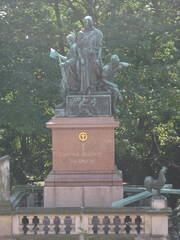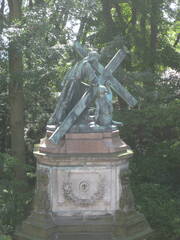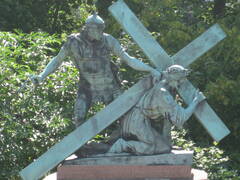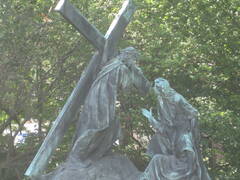Good Friday 2003
Via Crucis at the Colosseum
This year's meditations & prayers were all by Blessed Pope John Paul II.
Introduction by Bishop Piero Marini
- in English, French, German, Italian, Portuguese & Spanish
A sign of fidelity
The Way of the Cross is one of the devotional practices dearest to the Holy Father’s heart. This attachment is deeply rooted in his family tradition, in the practices of the parish where Karol Wojtyla was baptized, and in the pastoral life of the Church in his native Poland, which can be likened to a body, wounded, torn and plundered by foreign powers, in which the mystery of Christ’s Passion has been prolonged. It is easy to see how the pious practice of the Way of the Cross, in the form it had taken by the early 18th century with the approval of the Apostolic See, spread rapidly throughout Poland, and took root in the fertile soil of popular devotion.
From the time that God’s Providence called him to the Chair of Peter (16 October 1978), Pope John Paul II has always taken part in the Way of the Cross at the Colosseum on the evening of Good Friday. In this setting the Holy Father experiences a deep bond between Jerusalem, the city where Jesus, carrying his Cross, took the last steps of his life’s journey; Krakow, his former episcopal see, whose Cathedral, standing on Wawel hill, long the heart of the monarchy and the Church, symbolizes Poland in its glory and in its suffering; and Rome, the see of the Successor of Peter, to whom Jesus entrusted the task of confirming his brethren in the faith (cf. Lk 22:32) and feeding his sheep (cf. Jn 21:15-17), and to whom he addressed his final, peremptory command: “Follow me” (Jn 21:22).
Two Jubilees of the Redemption
During the papacy of Pope John Paul II, two Jubilees of a universal character have been celebrated: the first, in 1983-1984, commemorated the 1950th anniversary of the Redemption, while the second, in 2000, marked the 2000th anniversary of Christ’s birth. For both these Jubilees, the meditations and prayers of the Good Friday Way of the Cross were composed by the Holy Father himself.
The Jubilee of 1984
In his 1984 Way of the Cross, Pope John Paul II wrote: “Jesus of Nazareth – at the end of his earthly pilgrimage – had to become completely one with the Cross, joining himself to it, merging with it, in a single sign of salvation for the world”. The text of this Way of the Cross is an invitation addressed to every man and woman to enter “into the profound Mystery of the Redemption”. Without entering into this Mystery, there can be no salvation for humanity; once the light of hope is extinguished, we plunge into the darkness of a life of despair.
The prayers of the 1984 Way of the Cross are for the most part quite brief: intense invocations which probe the unprecedented paradox that the supreme injustice – the condemnation of Jesus, the Just One, to an ignominious death – has become the source of our life, the source of all grace.
The Jubilee of 2000
For the 2000 Way of the Cross, the meditations are longer, with more biblical citations, and more developed prayers. The meditations and prayers are perceptive commentaries on the different “stations” being contemplated, yet the thoughts of the Holy Father are now turned to the event dominating the year 2000: the celebration of the 2000th anniversary of Christ’s birth. Jesus was born to be the spotless Lamb sacrificed for our sins (cf. 1 Jn 2:2; Rom 3:25). He was born to be our High Priest and to offer the sacrifice of our redemption on the altar of the Cross. But since the year 2000 also signaled the dawn of a new millennium, the Pope’s thoughts naturally turned to the opening of the third millennium of the Christian era. This era too must be sealed by the “sign of God’s saving love for mankind”: only “by bringing into the new millennium the sign of the Cross, will we be authentic witnesses of the redemption”.
In the 2000 Way of the Cross we find echoes of Polish culture and popular devotion: quotations from Lenten hymns, reflections by intellectuals and allusions to images dear to the Christian faithful such as the Sorrowful Benefactress (“Smetna Dobrodziejka”) venerated in the Church of the Franciscan Friars of Krakow. The figure of Our Lady of Sorrows is evoked in the fourth, eighth, twelfth, thirteenth and fourteenth stations.
The Jubilee of the Pontificate
Together with the great Jubilees of 1984 and 2000, the papacy of Pope John Paul II now marks yet another jubilee. It is a jubilee of a different kind and with a different motivation. In 2003 Pope John Paul II celebrates the 25th anniversary of his pastoral ministry as the Bishop of Rome. This event is universal, since it involves the Pastor of the Universal Church, and although not celebrated officially, it remains deeply significant, especially for the Holy Father himself, for his Diocese of Rome, for his closest collaborators and for the Catholic faithful throughout the world. This jubilee naturally becomes a moment of thanksgiving to God for the gift he has given to the Church in Pope John Paul II and a prayer that the Lord will grant him strength, support and wisdom in his daily, tireless concern for all the Churches.
Although the Way of the Cross for this jubilee was also written by the Holy Father, it was composed not for the present anniversary but for the retreat that the then Cardinal Archbishop of Krakow preached in 1976 to Pope Paul VI and the Roman Curia in the Mathilda (now Redemptoris Mater) Chapel in the Vatican. Under the striking title Sign of Contradiction (cf. Lk 2:34), these meditations were published first in 1977 and again in 2001. The Holy Father has now returned to this Way of the Cross, allowing it to emerge, as it were, from the secluded setting of the Mathilda Chapel and onto the universal stage – a true Statio Urbis et Orbis – of the Colosseum, the Roman Forum and the Palatine Hill on Good Friday evening. This decision provides us with an opportunity to see how the magisterium of Pope John Paul II – “so rich, so great, so relevant” – is in so many ways “already present in germinal form in Sign of Contradiction”.
“Sign of Contradiction”
As the Holy Father was considering the Way of the Cross this year, the world was increasingly troubled by the ominous threat of a massive war. Jesus, the “Prince of Peace” (Is 9:5), once more became a “sign of contradiction” (cf. Lk 2:34): the world has met his offer of love with hatred, countering his life-giving light by murderous darkness, choosing lies and oppression over the truth and freedom that he brings. The Holy Father, in fidelity to the mission he has received from Christ, sought to avert the outbreak of the war by his firm, impartial words, by numerous diplomatic initiatives, and above all by fasting, prayer and trusting recourse to Our Lady.
But the Holy Father’s anguished warnings were not heeded, and 20 March 2003 saw the devastating eruption of the war. The 1976 text of his Way of the Cross has not been modified. It had, and continues to have, a tragic timeliness: “The earth has become a burial ground. With as many burial places as there are men. A great planet of tombs. In one of the countless tombs scattered all over the continents of this planet of ours the Son of God, the man Jesus Christ, conquered death with death. O mors! Ero mors tua! (First Antiphon of Morning Prayer for Holy Saturday).” But not even the new tombs, in growing numbers, created by the present war will be able to bury hope or to prevent Christ’s victory over death.
Under the banner of the Blessed Virgin Mary
The beginning of the jubilee of Pope John Paul II’s episcopal ministry in Rome (16 October 1978-2003) coincided with the promulgation of the Apostolic Letter Rosarium Mariae Virginis, in which the Holy Father proclaimed the Year of the Rosary (16 October 2002-2003). The 2003 Way of the Cross will also take place under the banner of Our Lady. Cardinal Stefan Wyszynski, Primate of Poland and a heroic witness to the faith, tells us that Cardinal Karol Wojtyla was reluctant to accept Paul VI’s invitation to preach the 1976 Retreat, but finally accepted, putting his trust in Mary, since he felt that he was a son “of that Nation which is accustomed to say ‘yes’ only to God, to the Church of Christ and to his Mother”.
In the Opening Prayer of the 2003 Way of the Cross, the Holy Father observes:
With us too is the Blessed Virgin Mary. She stood on the hill of Golgotha as the Mother of the dying Son, as the Disciple of the Teacher of truth, as the new Eve standing beneath the tree of life, as the woman of sorrow, the companion of the “man of sorrows, acquainted with grief” (Is 53:3), the Daughter of Adam, Our Sister, the Queen of Peace. As the Mother of Mercy, she bends over her children who still face dangers and exhaustion, to see their sufferings, to hear the cry arising from their afflictions, to bring them comfort and to renew their hope of peace.
1st Station - Jesus is condemned to death
in English, French, German, Italian, Portuguese & Spanish
From the Gospel according to Mark (15: 14-15):
But the crowd shouted all the more, "Crucify him". So Pilate, wishing to satisfy the crowd, released for them Barabbas; and having scourged Jesus, he delivered him to be crucified.
Meditation
Pilate's verdict was pronounced under pressure from the priests and the crowd. The sentence of death by crucifixion was meant to calm their fury and meet their clamorous demand: "Crucify him! Crucify him!" (Mk 15:13-14). The Roman praetor thought he could dissociate himself from the sentence, washing his hands of it, just as he had already distanced himself from Christ's words identifying his Kingdom with the truth, and with witness to the truth (Jn 18:38). In both instances Pilate was trying to preserve his own independence, to remain somehow "uninvolved". So it may have seemed to him, on the surface. But the Cross to which Jesus of Nazareth was condemned (Jn 19:16), like the truth he told about his Kingdom (Jn 18:36-37), had to strike deep into the Roman praetor's soul. All this was, and is, a single reality, in the face of which one cannot remain uninvolved, on the sidelines.
When Jesus, the Son of God, was questioned about his Kingdom and, because of this, was judged guilty by men and condemned to death, his final testimony began: he was about to demonstrate that "God so loved the world..." (cf Jn 3:16).
We have this testimony before us, and we realize that we are not allowed to wash our hands of it.
Acclamation
Jesus of Nazareth, condemned to death on the Cross, faithful witness to the love of the Father.
Kyrie, eleison.
Jesus, Son of God, obedient to the will of the Father, even unto death on a Cross.
Kyrie, eleison.
2nd Station - Jesus takes up his Cross
in English, French, German, Italian, Portuguese & Spanish
From the Gospel according to Mark (15:20):
After they had mocked him, they stripped him of the purple cloak, and put his own clothes on him. And they led him out to crucify him.
Meditation
The execution, the implementation of the sentence, is beginning. Christ, condemned to death, must be burdened with the Cross just like the two other men who have received the same punishment: "he was numbered with the transgressors" (Is 53:12). Christ draws near to the Cross, his body atrociously bruised and lacerated, blood running down his face from his head crowned with thorns. Ecce Homo! (Jn 19:5). In him we see all the truth foretold by the Prophets about the Son of man, the truth proclaimed by Isaiah about the servant of Yahweh: "He was wounded for our transgressions... and by his stripes we are healed" (Is 53:5).
In him we see also the amazing consequence of what man has done to his God. Pilate says: "Ecce Homo" (Jn 19:5):
"Look what you have done to this man!" But there seems to be another voice speaking as well, a voice that seems to be saying: "Look what you have done, in this man, to your God!"
It is very moving to hear this voice from centuries ago, as it blends with the voice coming to us from what we know in faith. Ecce Homo!
Jesus "who is called the Messiah" (Mt 27:17) takes the Cross upon his shoulders (Jn 19:17). The execution has begun.
Acclamation
Christ, Son of God, you reveal to man the mystery of himself.
Christe, eleison.
Jesus, Servant of the Lord, by your stripes we have been healed.
R. Christe, eleison.
3rd Station - Jesus falls for the first time
in English, French, German, Italian, Portuguese & Spanish
From the Book of the Prophet Isaiah (53: 4-6):
Surely he has borne our griefs and carried our sorrows; yet we esteemed him stricken smitten by God, and afflicted. But he was wounded for our transgressions, he was bruised for our iniquities; upon him was the chastisement that made us whole, and with his bruises we are healed. All we like sheep have gone astray; we have turned every one to his own way; and the Lord has laid on him the iniquity of us all.
Meditation
Jesus falls under the weight of the Cross. He falls to the ground. He does not resort to his superhuman powers, he does not resort to the power of the angels. "Do you think that I cannot appeal to my Father, and he will at once send me more than twelve legions of angels?" (Mt 26:53). He does not ask for that. Having accepted the cup from the Father's hands (Mk 14:36) he is resolved to drink it to the end. This is as he wills it. And so he has no thoughts of any superhuman force, although such force is at his disposal. Those who saw him when he showed his power over human infirmities, crippling diseases and even death itself, may well, in their grief, have wondered: "What now?" "Is he repudiating all that?" In a few days the disciples on the road to Emmaus would say: "We had hoped" (cf Lk 24:21). "If you are the Son of God...." (Mt 27:40), the members of the Sanhedrin were to fling at him. And the crowd would yell: "He saved others but he cannot save himself" (Mk 15:31: Mt 27:42).
He accepts these provocations, which seem to undermine the whole meaning of his mission, his teaching, his miracles. He accepts them all, for he is determined not to combat them. To be insulted is what he wills. To stagger and fall under the weight of Cross is what he wills. He wills it all. To the end, down to the bitter end, he is faithful to what he had said: "Not my will, but yours be done" (cf Mk 14:36, etc).
God will bring forth the salvation of humanity from Christ's falling beneath the weight of the Cross.
Acclamation
Jesus, meek lamb, Redeemer, you bear the sin of the world.
Kyrie, eleison.
Jesus, our companion at times of suffering, you share in our human weakness.
Kyrie, eleison.
4th Station - Jesus meets his Mother
in English, French, German, Italian, Portuguese & Spanish
From the Gospel according to Luke (2:34-35, 51)
Simeon said to Mary, his mother, "Behold, this child is set for the fall and rising of many in Israel, and for a sign of contradiction, that thoughts out of many hearts may be revealed. And a sword will pierce through your own soul also"... His mother kept all these things in her heart.
Meditation
The Mother. Mary meets her Son along the way of the Cross. His Cross becomes her Cross, his humiliation is her humiliation, the public scorn is on her shoulders. This is the way things are. So it must seem to the people around her, and this is how her own heart reacts: "And a sword will pierce through your soul also" (Lk 2:35). The words spoken when Jesus was forty days old are now fulfilled. They are now completely fulfilled. And so, pierced by that invisible sword, Mary sets out towards her Son's Calvary, her own Calvary. Christian devotion represents her with this sword penetrating her heart, in paintings and sculpture. Mother of sorrows!
"You who shared his suffering!", say the faithful, who know in their hearts that the mystery of this suffering can be expressed in no other way. Although this pain is hers, striking deep in her maternal heart, the full truth of this suffering can be expressed only in terms of a shared suffering - 'com-passion'. That word is part of the mystery; it expresses in some way her unity with the suffering of her Son.
Acclamation
Holy Mary, our Mother and Sister in the journey of faith, with you we call upon your Son Jesus.
Kyrie, eleison.
Holy Mary, you did not hesitate along the way to Calvary, with you we call upon your Son Jesus.
Kyrie, eleison.



